How to Build a More Powerful Engine: Expert Advice
"A Guide to Choosing Performance Engine Connecting Rods."
Conrods, Pistons, and Crankshafts take a real beating and in a performance engine these are often the points of failure, so we'll look at these components, how they work together. We will also look at building a stronger engine and help you decide on your options.
An engine that performs well requires high-performance pistons, crankshafts, and conrods.
Let's look at Conrods first.
To move the conrod and rotate the crankshaft, a piston must create pushing and pulling forces. Therefore, it is critical to select the proper design and style for your system. Choosing the correct conrod for your vehicle will be covered in great detail.
Explanation as to what a conrod is and what it does?
A piston engine's connecting rod (conrod) is a key component. Assembling the crankshaft and piston The reciprocating action of the piston is converted into a rotational motion for the driveshaft by the crankshaft and conrod.
Power (or reciprocal movement) is converted into rotational force by virtue of a conrod's work. This type of internal combustion engine would not run if it didn't have one.
The big end of the crankshaft is attached to crank pin by way of sliding bearing.
The piston pin and a bearing bushing are located in the tiny end. The pistons are generally lubricated through the drilling of an oil conduit through the conrod.
Inertial Forces, Tensile Loads, and Compressive Loads
The piston's compressive and inertial forces are transmitted to the crankshaft by the conrod, which rotates and pivots at both ends.
Engine rotational force is transferred to the transmission, which in turn powers the driveshafts and wheels.
A component is subjected to a tensile load when force is applied lengthwise to it. A compressive load, on the other hand, is a force exerted on the component that pushes it inward. Circumferential forces, also known as centrifugal forces, are the forces exerted on a moving component across a circular route.
As a result, the conrods will expand and contract under normal driving conditions. That's right a piece of metal will change shape as it is doing it's job, in addition to the heat related expansion and contractoin.
Finally, a conrod will fail due to metal fatigue produced by vibration, stretching and contraction, and heat, or stress fractures that were inherent in the manufacturing process.
Choosing the right material for your conrods can be a challenge because of the stress and strain they are subjected to by the engine.
Choosing between being flexible or strong is the trade-off here, and it depends on the engine's design, whether it's a short or long-throw block, and even the arrangement of the cylinders.
The qualities of a rod are substantially influenced by its design, forging, and treatment throughout its fabrication.
A hard steel or a strong conrod isn't always the best choice for every application, it needs to exhibit Metallographic qualities that suit your application. This is especially true when considering factors such as lifetime and rotating pressures.
Whic is the best design for performance conrods.
When it comes to picking the right conrods, you have two major options: I beam or H beam setups, both of which are described in the following paragraphs.
Although these generalizations have gotten somewhat muddled due to the complexity of current production and raw material selection, many tuners still see them as a rule of thumb.
I beam.
Much larger in stature than its smaller counterparts. Because they are easier to process, they are more cost-effective than H beams.
If the same material and length were taken into account, they would be regarded lighter than a H beam when installed on stock engines.
H-Beam
The H beam system gets its name from the fact that a cross section taken along the main shaft resembles an H.
Flat, wide edges that go the entire length of the rod, with a much narrower middle section.
In high-power, high-torque applications, they are more expensive to machine, but their performance is superior.
The image above shows an H beam performance conrod design.
Processes and raw materials
Alloys of steel, titanium, and other metals
Conrods are made from a variety of materials and using a variety of procedures. Alloy and micro-alloyed steel and sintered metal with iron as the primary constituent are examples of this class of metal.
A machined billet is typically used to make a conrod in high-performance applications.
While the conrod is typically made of cast or forging steel in a typical road automobile.
Another lightweight metal alloy is aluminum alloy, which can be machined from a billet of raw material.
Even while aluminum's tensile strength is lower than steel's (approximately 97,000 psi), the tradeoff is a rod that can spin at higher RPMs and change rev rates more quickly because of its smaller weight (30 percent less than steel).
Because of the low weight, more material can be used to make up for the lack of strength.
Adding aluminum to the engine will help it last longer by absorbing more shocks and vibrations. If you're running a race-spec engine, you'll need to replace it sooner rather than later.
Parts machined for optimal high-temperature clearances have considerably larger clearances while it's cold, making it more critical to warm up the engine before driving hard on it, as it expands faster.
The utilization of machined parts is due to their ability to be customized.
In the same way as casting and forging, expensive dies need to be created and have a limited life expectancy. As a conrod material, titanium is extremely light but a lot more expensive than aluminum.
There are a plethora of uses for steel, therefore it's not simply "steel" there are many grades and processes.
Different kinds of steel are classified according to their nimber content, which represents the chemical composition. Steel has a tensile strength of 200,000 psi or more, depending on the grade and processing methods employed.
For example, steel with a 43XX number is likely to include nickel and molybdenum, whereas steel with a 51XX number is not.
The second two digits indicate the amount of carbon in the steel, which indicates stronger steel.
40 percent carbon
Steels with low carbon content like 5140 can be a viable alternative to keep costs down, but in high-performance engines where heat and pressures are significantly higher, an investment in a high-carbon alloy of steel like 4340 or 4330 will be necessary.
The steel's properties and appropriateness for your application can also be affected by a variety of heat treatments, chilling, heating, cryo treating, and similar techniques.
Machining, forging, and casting
In order to forge, a piece of metal must be heated to a high enough temperature to make it pliable.
High-pressure dies are used to crush this material into shape. The component is subsequently finished by machining procedures to the desired dimensions and surface imperfections. Imagining a blacksmith using a mallet to pound a hot metal
Unlike melting, casting uses a mold formed of sand and then separates the molten substance once it has cooled.
There is a line where the mold's two sides meet where casting creates a dividing line.
Diamond-tipped cutters are used in CNC machines to remove layers of material by using a spinning robotic arm or drill to process the material. Single-block manufacturing of a conrod.
For high-performance engines, casting is a bad choice since it doesn't produce a proper grain structure.
Forging creates a grain structure that "flows" around the large end of the conrod, resulting in an additional 20% in strength.
When a rod is machined, it retains the grain structure of the parent rod from which it was cut, as well as having a very smooth surface, which helps to reduce friction and drag.
Strength's benefits and drawbacks
Steel is deemed less appropriate for high-strength applications in a high-performance configuration.
It's challenging to redesign and optimize for performance because of the old manufacturing procedures. However, they are easily mass-produced and well-suited to applications requiring less power.
The strength and durability of titanium conrods make them ideal for use in race engines. While still being the greatest all-around lightweight design option.
Titanium, on the other hand, is the most expensive option.
Because titanium racing components must normally be replaced every 40-80 hours of use due to wear and tear, this is a significant consideration when using titanium.
Heat treatment and stress release are typically performed during extrusion procedures, which produce aluminum.
A more stable rod is the result, and this rod can be machined in a variety of ways to provide the best possible version for your application.
In addition, it is less expensive than titanium. When used in track racing, aluminum is less durable because it absorbs more shock, reducing the stress on the crank shafts. As a result, the engine experiences more flexing and a shorter lifespan.
Weight gain and loss
When it comes to reducing compression forces on charged engines, the H beam conrod is the best option. Charged engines are more prone to bending because of their lightweight design, which uses less material, because the forces placed on them are not linear.
In the past, it was assumed that an I beam conrod was heavier than a conventional conrod, however this is no longer the case.
More machining procedures can improve its lightweight design. Because of their more robust production techniques and high-strength steel structure, these engines are often capable of sustaining up to 1,000 horsepower.
When it comes down to it, a slew of variables affect the lifespan and material selection of the ideal conrod.
For short-distance drag racing, an aluminum rod provides a low-cost and lightweight alternative.
Titanium is the preferred material for use in high-end track motorsports like NASCAR and Formula 1.
Steel, on the other hand, is a more cost-effective and long-lasting material for low-power performance applications.
It's time to move on to the next most crucial internal components of a performance engine: the pistons and the crankshafts.
It's easy to overlook the importance of a piston in boosting your engine's horsepower and torque numbers. It's possible that the tight tolerances and margins required by your application are partly to blame, as they are difficult to replace, costly, and dangerous if not estimated correctly.
In addition, the engine's moving parts must be perfectly balanced and precisely matched. If you don't, you could end up with a slew of disastrous outcomes down the road as parts fail under stress.
The Piston's Function
The camshaft rotates four times for every two revolutions of the piston in a four-stroke configuration. During this cycle, the intake and exhaust valves are opened at particular times.
Suck Squeeze Bang Blow is a good way to summarize the process (or Intake, Compression, Combustion and Exhaust). Each has a different piston position in the cylinder block/head of an engine as it rises and lowers.
The Piston's Components
The crown, or top surface, is the primary component of a piston. Both the skirt and the pin where it joins to the conrod are important. The crowns of each piston feature two to four grooves indented around the edge.
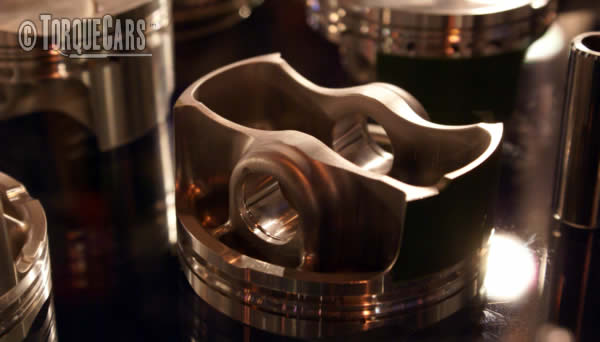
By withstanding the pressure, these "ring lands" enable for the installation of closely fitting alloy rings on the piston, forming a seal and preventing the entry of oil into the combustion chamber.
There are various kinds of pistons.
When it comes to pistons, there are a variety of options to choose from.
For stock, you need to replace with the same factory features, a supercharged or turbocharged engine requires low compression pistons, and performance naturally aspirated race engines require high compression pistons for increased peak power...
Pistons with Flat Tops
In today's engines, the top of the piston has three primary designs. Design-wise, flat-top pistons are the most common.
High performance engines and street cars alike can benefit from their versatility in terms of compression ratios and valve clearances.
Pistons with Dished Bores
In contrast, the dish-shaped pistons have a concave shape similar to a dish. These are found in turbocharged or supercharged engines, where they aid compression reduction. The higher the compression ratio of these engines, the greater the chance of engine failure.
With Domed Pistons
Smaller combustion chambers and greater compression rates necessitate domed pistons. It's the goal, but other concerns such as incomplete combustion, sluggish burning and valve interplay might also arise, resulting in a less efficient configuration.
It is only suitable for a limited set of circumstances. They also need valve reliefs, which are small indents cut into the crown of the piston to prevent the valves from striking the pistons.
Piston Components and Methods of Production.
The manufacturing method for pistons is integrated into the piston design so the construction helps produce the qualities you need in the piston.
Each of the three basic procedures should be highlighted for its suitability.
Pins and Bolts
A mold made of aluminum is used to pour molten liquid metal into, and the piston is then finished on a machining tool after it has hardened and cooled.
This method's advantages include its repeatability and lower prices, as well as its casting's suitability for engines with low to medium horsepower.
Cast pistons, on the other hand, are not up to the rigors of racing engines with greater compression ratios.
Pistons with a High Temperature Limit
Hypereutectic pistons, like casted aluminum pistons, contain silicon.
For high-compression engines, this means improved tolerances for piston clearances and an increase in piston strength over cast pistons.
This is the most widely used technique for modifying street-legal engines.
Pistons made of Forged Metal
Made from a single piece of solid material. Creating a more robust and durable piston design, which is excellent for compression figures of exceptionally large magnitudes.
Casting and Hypereutectic techniques are significantly less expensive alternatives.
For turbo and supercharged engines, TorqueCars recommends Forged components, there is no substitute for strength.
Increasing Performance by Upgrading a Crank
The Crankshaft plays a critical part in the engine's ability to utilize the pushing and pulling force of the pistons and conrods to its full potential.
It is therefore an essential component and needs to be considered when building a stronger engine.
It's critical to strike a balance between maximizing performance and making the small adjustments necessary to maintain a competitive advantage when racing.
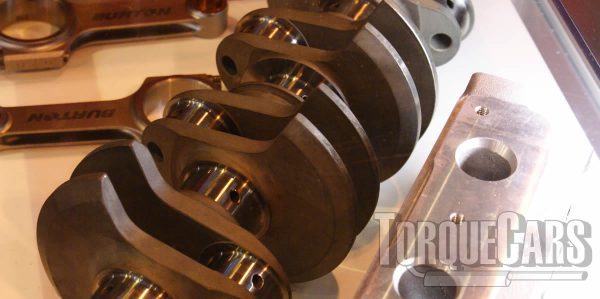
Pros and Cons of Crank Manufacturing
Cast iron or forged steel crankshafts are used in stock and road engines.
Forged parts, which can take higher loads while remaining small and light, are becoming increasingly popular in common applications as consumers strive for improved fuel efficiency.
High-Performance Crankshafts
A crank can only take so much abuse before it needs to be upgraded or altered.
Because of their increased robustness and reduced likelihood of splitting or winding, high-rpm performance cranks are an ideal solution in this situation.
Precision production technologies and greater tolerances have resulted in the following developments and advances for racing:
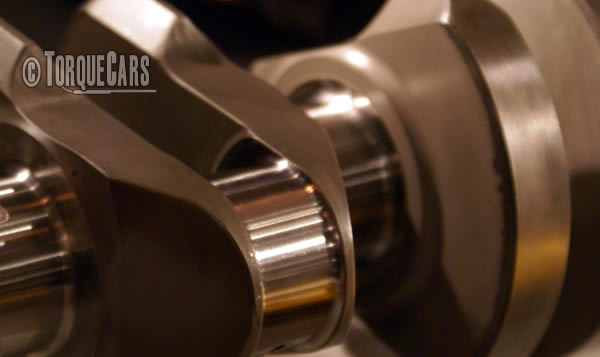
Journals
Conrods have a pivot point in the form of the crank's journal.
A high-performance engine polishes them to a mirror finish to reduce friction and improve mobility.
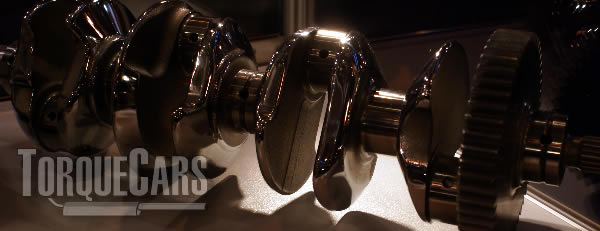
Counterweights
To counteract the rotating crank's inertia and maintain a steady rotation, these components are employed.
Their edges are sharpened. As a result, the counterweight's outside edges become narrower, giving the weight a tapered appearance and a sharp tip at the end.
Assisting in reducing engine winding and drag, as well as improving oil control.
Lubrication considerations for a performance crank
Cross-drilled and chamfered oil holes are also found in performance engines to enhance lubrication.
Allowing for greater flow through additional slots drilled into the journals.
Nitrocarburizing and Nitriding
Both procedures deal with the thermochemical process that crankshafts go through, which is characterized by low heat and little deformation. Heating the crank in an oven loaded with nitrogen to roughly 500°C is an example of nitriding.
Nitrocarburizing, on the other hand, is the process of heating a "ferric nitrocarburizing" solution to a high temperature before immersing the crank in the solution.
Nitrogen reacts with the metal in both cases, hardening the crank's outer layer to a depth of 0.5-0.75mm. Double the surface hardness and not a drop in the base substance. It will, however, increase the cost of your crankshaft, but we recommend it.
Cryogenic treating
Some cranks are even cryogenically treated, which freezes the crank to hundreds of degrees below zero and then gently raises the temperature back to its original state.
In high-stress locations, this is perfect for re-aligning the structure of the metal and reducing potential difficulties
Concluding comments and suggestions
In the end, the crank's basic material and manufacturing technique are merely one aspect.
For a racing crankshaft, fillets at each journal, the counterweight form and location, the number of oil holes and drilling process all have a role in the design of each journal's fillet.
The extra processes of Nitriding/Nitrocarburizing or Cryo treatments will also play a significant role, as you can see there are many different possibilities available.
If you need high-compression pistons, TorqueCars propose forged pistons; nevertheless, you can choose the method that best suits your needs.
So TorqueCars urge you to look at all of the components when building a stronger engine.
Work out what compression ratio you need and whether you build will be a long or short travel and high or low rpm then choose the components that suit these requirements.
Please join us in our forum to discuss the pistons, crank and conrod options in more detail with our members. It would also be worth reading our tuning articles to get a full grasp of the pros and cons of each type of modification.
Please Check out my YouTube channel, we're regularly adding new content...
PLEASE HELP: I NEED YOUR DONATIONS TO COVER THE COSTS OF RUNNING THIS SITE AND KEEP IT RUNNING. I do not charge you to access this website and it saves most TorqueCars readers $100's each year - but we are NON PROFIT and not even covering our costs. To keep us running PLEASE Donate here
If you liked this page please share it with your friends, drop a link to it in your favourite forum or use the bookmarking options to save it to your social media profile.
Feedback - What do You Think?
Please use our forums if you wish to ask a tuning question, and please note we do not sell parts or services, we are just an online magazine.
Help us improve, leave a suggestion or tip
Please watch this video and subscribe to my YouTube channel.

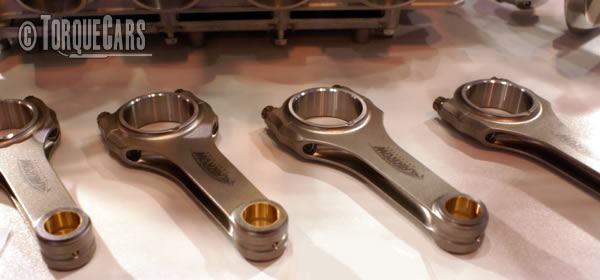
 Click to accept YouTube Cookies & Play.
Click to accept YouTube Cookies & Play.